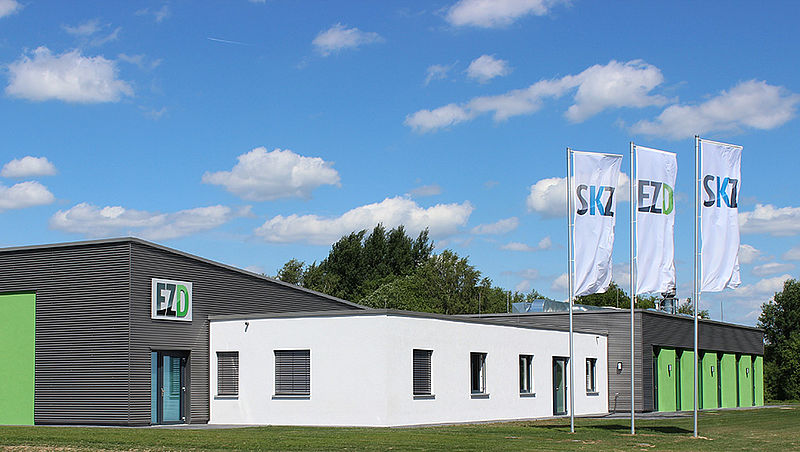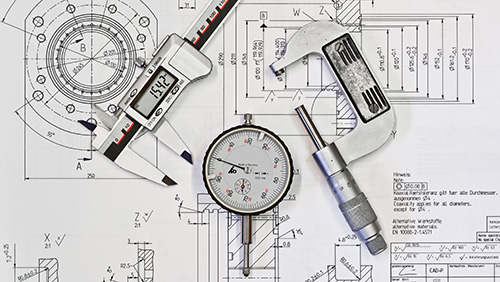Find projects
Particle Measurement
The particle size or particle size distribution of fillers and additives have a significant influence on the properties and characteristics of the stock systems in which they are incorporated. Among other things, the particle size or particle size distribution influences the mechanical properties (hardness, tensile strength), the rheological behavior (flowability), the physical stability (sedimentation) and the appearance (color, gloss, surface roughness) of the dispersed system. But also the electrical and the catalytic behavior can be changed specifically by the addition of particles.
In addition to particle size analysis (granulometry), particle measurement technology deals with the characterization of optical and electrical properties, agglomeration behavior and the rheology of particle systems. The wide variety of particle measurement technology and the associated measurement methods are supported by the technical and scientific staff of the SKZ at the Würzburg and Selb sites.
The knowledge of particle measurement technology helps to better understand the (manufacturing) process and to control it reliably with high reproducibility. As a result, yield and quality can be secured or increased.
We are happy to support you in
- Analysis and evaluation of your products in the field of particle measurement technology
- Development of quality control work instructions (SOP)
- Application-oriented research and development (e.g. in the field of online measurement technology for dispersion or process monitoring)
- Process and material optimization in the field of dispersion
- Development of new materials with improved properties
- Training of employees in the field of particle measurement technology and dispersion
Services
The determination of the mean particle size or particle size distribution has been a focus of SKZ R&D at the Selb site for many years. In our analytics laboratory, different measurement methods are available for the characterization of suspended particles from the micrometer to nanometer range. In addition to the dry analysis of powders by means of sieving or optical and scanning electronic microscopy, a defined dispersion of the powders in liquid/flowable media for characterization of these is also possible.
The shape of particles has an optical (color, gloss) and rheological influence on the behavior of dispersions. With the help of optical and scanning electronic microscopy, an evaluation of the shape (shape factor or sphericity) of particles is possible at SKZ.
How long is your dispersion stable? How fast does sediment form and how large does it form? Does my emulsion frame up? These and other questions about dispersion stability can be answered using sedimentation analysis, rheology and zeta potential. Together we will find the right questions and their answers.
As experts in the field of plastics technology, we strive to pass on the knowledge we have acquired over decades to our customers. From material development and manufacturing processes to the application of various testing and measuring methods - in our numerous practice-oriented training courses, you as a participant will acquire the necessary knowledge in dealing with plastics as a material. This begins with the selection of the right materials and compliance with production-oriented design rules, continues with the correct handling of equipment and machines for the manufacture and processing of plastic components and ends with the correct understanding of quality criteria and the associated use of testing and measuring tools.
Bringing together people from different areas of the company and from different sectors to exchange experiences and technical know-how is also a top priority for us, in addition to the pure transfer of knowledge. Our numerous specialist events provide the ideal venue for a free exchange of ideas. Renowned speakers from a wide range of industries and excellent technical presentations make the SKZ conferences popular meeting places within the plastics industry.
Rheology is used to describe the flow behavior and viscoelastic processes (yield point, stress profile, etc.) in a material system. Defined characteristic values can in turn be used to investigate technical issues such as sedimentation behavior, the dripping of paints and adhesives or the curing of resins.
Various methods and measuring geometries are available at SKZ for this purpose, thus enabling the rheological characterization of powders, plastic melts and dispersions. An application is equally possible, for example, to monitor the curing of adhesives and sealants.
Particles play a decisive role in the formation and properties of surfaces / coatings, such as scratch resistance, color, transparency and gloss. With the help of different application processes for the production of defined surfaces and the associated measuring techniques, the properties can be checked and adjusted at the SKZ of coating dispersions.
Particle measurement technology represents a broad field of application, which has been state of the art in the field of laboratory measurement technology for many years. Different measuring principles based on visual camera systems, laser diffraction and ultrasonic waves enable, for example, the size determination of particles in suspensions. SKZ also offers inline determination of particle size distributions and filler contents in plastic melts as well as non-destructive quantification on components, also with the aim of describing the dispersion quality or detecting agglomerates.
For example, a system based on ultrasound and terahertz waves for monitoring the dispersion quality of fillers and additives introduced into plastic melts was successfully developed (ZIM funding program: KF2012537KM2). Furthermore, the SKZ was involved in the development of the inline particle analysis system IPAS and now uses this in its laboratory. The innovative IPAS enables the quasi-continuous determination of particle size in low-viscosity systems by means of dynamic light scattering (DLS) (ZIM funding program: FKZ 16KN048522).
Technical equipment
Two laser diffraction analyzers based on the principle of extended static light scattering are available to determine particle size from the nanoscale range through the submicrometer to millimeter range (~ 0.1 µm to 2 mm):
- Laser diffractor for particle size analysis of suspended particles; can also be coupled with dynamic image analysis.
- Laser diffractor for particle size analysis of powders and suspended particles
For the determination of particle size in the nanoscale and submicron range, dynamic light scattering (DLS) is a widely used and established measurement method. Two measuring systems are available for this purpose:
- DLS measuring system as a plug-in probe for particle size analysis of suspended particles in the size range from 1 nm to 10 µm and solid concentrations from 0.01 % to 40 % (the limits are material dependent); can be combined with the IPAS for online particle size determination.
- DLS measuring instrument as cuvette system for size analysis of suspended particles in the range from 1 nm to 10 µm; determination of zeta potential by electrophoretic light scattering
By means of static image analysis, particle properties such as size, shape, transparency and number can be determined with spatial resolution. Various measuring instruments are available for this purpose:
- Microscopes with different magnifications of 2.5 x / 5 x / 10 x / 20 x / 50 x for the size range 1 µm - 1000 µm
- Automatic image evaluation system with different magnifications of 2.5 x / 5 x / 10 x / 20 x / 50 x for the size range 1.5 µm - 1000 µm
Scanning electron microscopy can be used to characterize, among other things, the size, shape and morphology of particles as well as topographies, surface and material defects down to the nanometer range. In combination with elemental analysis (EDX), a statement can also be made about the composition of the materials. The following equipment is available for this purpose:
- SEM with EDX unit with three different acceleration voltages (5 kV, 10 kV, 15 kV) and a magnification of up to 100,000 x
Spatially and time resolved measurement of the transmission of a dispersion is used to analyze the particle or droplet velocity during creaming or sedimentation. This information can be used to determine the particle size distribution (ISO 13318-2). For this purpose, different measuring systems are available for characterization under earth gravity field and accelerated centrifugal field:
- Measuring system for determining the sedimentation velocity in the earth's gravitational field for "fast" segregating systems
- Measuring system for performing accelerated stability analysis for particle systems in the size range from 20 nm to 100 µm
- Measuring system for the determination of dispersibility, stability and the separation phenomenon for completely transparent to completely opaque systems using X-rays
The following processes and measuring equipment are available for the application of powder coatings and the evaluation of surfaces:
- Powder coating system
Hand gun with corona charging
500 ml fluidizing cup
Perfect for small quantities
PowerBoost technology (110kV / 110μA) provides maximum coating performance
Precise Charge Control - mode (PCC 1μA - 10μA) for high quality coating tasks
- Squeegee system
Test stand with perforated vacuum plate for sizes up to A3 (297 x 420 mm)
Hardness test bar with 3 spiral springs for the test ranges: 0-300 g/0-3 N, 0-1000 g/0-10 N,-30 N, with spherical scribe needle ø 1 mm made of hard metal following ISO 1518
Speed of the transport crosshead: 2 - 500 mm/s with an accuracy of ± 1%.
heating: max. temperature: 125 °C
- Contact angle measurement
laboratory tensiometer for the determination of contact angle, surface tensions and energies as well as the wetting behavior of powders
portable device for measuring the contact angle of surfaces (with water, diiodomethane)
Calculation of surface free energy according to the models of Owens-Wendt-Rabel-Kaelble and Wu, Zisman and Fowkes, respectively
- Abrasion resistance: washability and abrasion tester
for the determination of abrasion resistance
automatic washability and abrasion tester for test specimens up to 35 mm
test according to ISO 11998, ASTM D4213, ASTM D2486
hardness tester with 3 spiral springs for the test ranges: 0-300 g/0-3 N, 0-1000 g/0-10 N, with spherical scribe needle ø 1 mm made of hard metal following ISO 1518
- Thickness measurement of total layers
Ultrasonic based: Thickness range: 10 µm to 10 cm, accuracy: 2 µm, measuring point by point.
Thermography-based: Thickness range: 5 µm to 5 mm, accuracy: 2 µm, direct imaging
- Thickness measurement of individual layers of a multilayer structure
Terahertz: Thickness range: 2 µm to 5 cm, accuracy: 2 µm, point-by-point measurement
- Adhesive strength
The adhesion tester automatically performs peel tests to evaluate the adhesion/cohesion of coatings to metal, wood, concrete and similar substrates.
Test stamp size 20 mm
Standards DIN EN ISO 16276-1, DIN EN ISO 4624, ASTM D4541
The particle size and concentration of pigments, but also that of additives, have a significant influence on the color of a component or dispersion. Different measuring instruments are available at SKZ for color measurement:
- Laboratory instruments with d/8° spherical geometry (reflection / transmission; with/without gloss trap).
- Measuring instruments with 45/0° geometry
- Inline colorimeter (45/0°) with integrated temperature sensor
- Glossmeter (20° / 60° / 85°)
European Center for Dispersion Technologies (EZD)
The European Center for Dispersion Technologies (ECD) is an interdisciplinary research and technology transfer center whose main focus is on the production and characterization of dispersions. Resin development is one of the main areas of focus. In order to offer these services to industry, the EZD has a competent team and a wide range of equipment in modern laboratories. The EZD was established in 2014 at the SKZ site in Selb.
More information on: www.ezd.eu








